
The Legend of Zelda is a video game series created by the Japanese game designers Shigeru Miyamoto and Takashi Tezuka. It is primarily developed and published by Nintendo; some portable installments and re-releases have been outsourced to Flagship, Vanpool, Grezzo, and Tantalus Media.
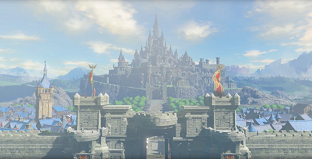
The Legend of Zelda is a video game franchise created by video game designers Shigeru Miyamoto and Takashi Tezuka and mainly developed and published by Nintendo. The universe of the Legend of Zelda series consists of various lands, the most predominant being Hyrule. The franchise is set within a fantasy world reminiscent of medieval Europe which consists of several recurring locations, races and creatures. The most prominent race in the series are the Hylians, a humanoid race with elfin features identifiable by their long, pointed ears. The series' lore contains a creation myth, several fictional alphabets, the most prominent being Hylian, and a fictional universal currency, the rupee. Most games in The Legend of Zelda series follow a similar storyline, which involves the protagonist Link battling monsters to save Princess Zelda and defeat a villain, which is often the series' main antagonist, Ganon. Nintendo developed the series' lore into a timeline that spans thousands of years across its history.

The Legend of Zelda: Ocarina of Time is a 1998 action-adventure game by Nintendo for the Nintendo 64. It was released in Japan and North America in November 1998 and in PAL regions the following month. The game is the first in the Legend of Zelda series with 3D graphics.
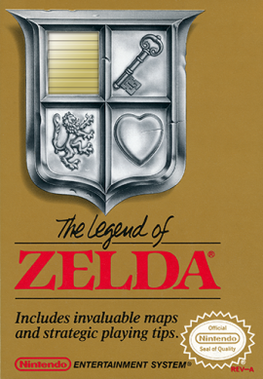
The Legend of Zelda, originally released in Japan as The Hyrule Fantasy: Zelda no Densetsu, is an action-adventure game developed and published by Nintendo. The first game of The Legend of Zelda series, it is set in the fantasy land of Hyrule and centers on an elf-like boy named Link, who aims to collect the eight fragments of the Triforce of Wisdom in order to rescue Princess Zelda from Ganon. The player controls Link from a top-down perspective and navigates throughout the overworld and dungeons, collecting weapons, defeating enemies and uncovering secrets along the way.

The Legend of Zelda: A Link to the Past is an action-adventure game developed and published by Nintendo for the Super Nintendo Entertainment System. It is the third game in The Legend of Zelda series and was released in 1991 in Japan and 1992 in North America and Europe.

The Triforce is a fictional artifact and icon of Nintendo's The Legend of Zelda video game franchise. It first appeared in the original The Legend of Zelda video game (1986) and has appeared in every subsequent game in the series. It consists of three equilateral triangles that are joined to form a large equilateral triangle. In-universe, it represents the essences of the Golden Goddesses—Din, Nayru and Farore—who created Hyrule. Imbued with divine power, it is capable of granting any wish to anyone who possesses it.

Princess Zelda is a character in Nintendo's The Legend of Zelda video game series. She was created by Shigeru Miyamoto for the original 1986 game The Legend of Zelda. As one of the central characters in the series, she has appeared in the majority of the games in various incarnations. Zelda is the elf-like Hylian princess of the kingdom of Hyrule, an associate of the series protagonist Link, and bearer of the Triforce of Wisdom.

Link is a fictional character and the protagonist of Nintendo's video game franchise The Legend of Zelda. He was created by Japanese video game designer Shigeru Miyamoto. Link was introduced as the hero of the original The Legend of Zelda video game in 1986 and has appeared in a total of 21 entries in the series, as well as a number of spin-offs. Common elements in the series include Link travelling through Hyrule whilst exploring dungeons, battling creatures, and solving puzzles until he eventually defeats the series' primary antagonist, Ganon, and saves Princess Zelda.

Ganon is a character and the main antagonist of Nintendo's The Legend of Zelda video game series and franchise, as well as the final boss in many Zelda titles. In his humanoid Gerudo form, he is known as Ganondorf. A massive and malevolent porcine creature, Ganon first appeared in the original The Legend of Zelda game in 1986, while his alter ego, Ganondorf, was introduced in Ocarina of Time. He has since appeared in the majority of the games in the series in various forms. He is the archenemy of the protagonist Link and Princess Zelda of Hyrule and originally the leader of the Gerudo, a race of humanoid desert nomads before becoming the ruler of his demon army.

The Legend of Zelda: Four Swords Adventures is an action-adventure game developed and published by Nintendo for the GameCube. It is the eleventh installment in The Legend of Zelda series. It was released in 2004 in Japan on March 18, and in North America on June 7. In 2005, the game was released in Europe on January 7, and in Australia on April 7. The Game Boy Advance handheld game console can be used as a controller when using the GameCube – Game Boy Advance link cable bundled with the game in North America and Europe.

The Master Sword is a fictional divine magic sword in Nintendo's The Legend of Zelda series. At times, it is referred to in-universe as the "blade of evil's bane" or the "sword that seals the darkness". It was introduced in the 1991 action-adventure video game The Legend of Zelda: A Link to the Past and has since appeared in most other games in the series.
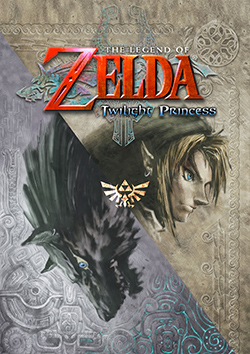
The Legend of Zelda: Twilight Princess is a 2006 action-adventure game developed and published by Nintendo for the GameCube and Wii. Originally planned for release exclusively on the GameCube in November 2005, Twilight Princess was delayed by Nintendo to allow its developers to refine the game, add more content, and port it to the Wii. The Wii version was a launch game in North America in November 2006, and in Japan, Europe, and Australia the following month. The GameCube version was released in December 2006 as the final first-party game for the console.

Midna is a fictional character in Nintendo's The Legend of Zelda series, introduced as one of the main protagonists in Twilight Princess. She is a member of the magic-wielding Twili who joins forces with Link to prevent the kingdom of Hyrule from being enveloped by a corrupted parallel dimension known as the Twilight Realm. While Midna appears as an imp-like creature in the majority of Twilight Princess, her actual form is humanoid. She was designed by Yusuke Nakano and voiced by Akiko Kōmoto. Midna also appears as a playable character in Hyrule Warriors, and makes minor appearances in the Super Smash Bros. series.

The Legend of Zelda: Hyrule Historia is a collector's book about Nintendo's The Legend of Zelda series, published in English by Dark Horse Comics. The 276-page book reveals the official timeline of the fictional events in the series, following years of speculation by fans. The book also includes artwork for the games, a short manga, and a foreword and afterword written by the series' producers. It is the first in an official trilogy of art books known as the "Goddess Collection" that was published by Dark Horse in partnership with Nintendo and was completed by the publication of The Legend of Zelda: Art & Artifacts and The Legend of Zelda Encyclopedia. Hyrule Historia topped Amazon.com's list of bestselling books in February 2013 and was Amazon's sixth best-selling print book of 2013.
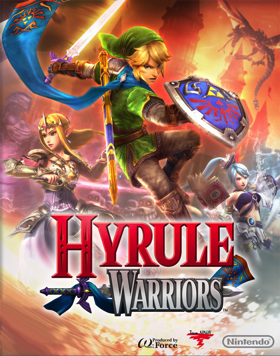
Hyrule Warriors is a 2014 hack and slash game developed by Omega Force and Team Ninja and published by Nintendo for the Wii U. The game is a collaboration between Koei Tecmo and Nintendo, mixing settings and characters from Nintendo's The Legend of Zelda with the gameplay of Koei's Dynasty Warriors series. Hyrule Warriors was released in Japan in August 2014, and worldwide the following month. It became one of the best-selling games on the Wii U. An updated port, Hyrule Warriors Legends, was released for the Nintendo 3DS in Japan in January 2016 and worldwide in March of the same year. A second enhanced port, Hyrule Warriors: Definitive Edition, was released for the Nintendo Switch in 2018. A successor, Hyrule Warriors: Age of Calamity, was released exclusively for the Nintendo Switch in November 2020.

Linkle is a fictional character who appears in various versions of Hyrule Warriors, a non-canon spin-off title in Nintendo's The Legend of Zelda series, starting with the 2016 Nintendo 3DS release of Hyrule Warriors Legends. She was originally featured in concept art for Hyrule Warriors, and was conceived as Link's sister, though this idea was rejected by The Legend of Zelda designer Eiji Aonuma who felt this conflicted with Link's sister, Aryll, in The Legend of Zelda: The Wind Waker.
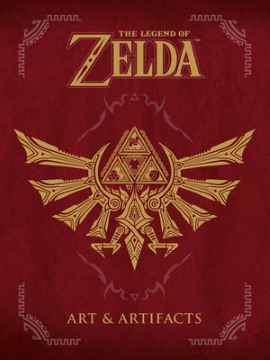
The Legend of Zelda: Art & Artifacts is an art collection book about Nintendo's The Legend of Zelda video game series. It is published in English by Dark Horse Comics out of a partnership with Nintendo and is the second book of an official series called the "Goddess Trilogy" that began with the publication of Hyrule Historia and was completed with the publication of The Legend of Zelda Encyclopedia. It was released on February 26, 2017 to celebrate the 30th anniversary of The Legend of Zelda series. The book provides a collection of illustrations created in the first 30 years of The Legend of Zelda video games. Two editions were published including a standard edition with a red cover and a purple limited edition that depicts the Master Sword on its cover.

Cadence of Hyrule: Crypt of the NecroDancer Featuring The Legend of Zelda is a rhythm game developed by Brace Yourself Games and published by Nintendo. The game is a crossover of Crypt of the NecroDancer with The Legend of Zelda, combining the rhythm-based movement and fighting mechanics with elements reminiscent of earlier games in the Zelda franchise. The game was released for the Nintendo Switch on June 13, 2019 to generally positive reviews from critics.

The Legend of Zelda: Breath of the Wild – Creating a Champion is a companion video game art book to Nintendo's 2017 video game The Legend of Zelda: Breath of the Wild. It was published in English by Dark Horse Comics on November 20, 2018, and is a localisation of a book titled Master Works that was published by Nintendo in Japan. It presents official illustrations and concept art from the game alongside development notes and also documents the fictional history of Hyrule presented in the game. The book was released as a standard edition with a white cover, a "Hero's Edition" featuring a blue cloth slip case and a "Champion's Edition" collector's box with a leather case.



















